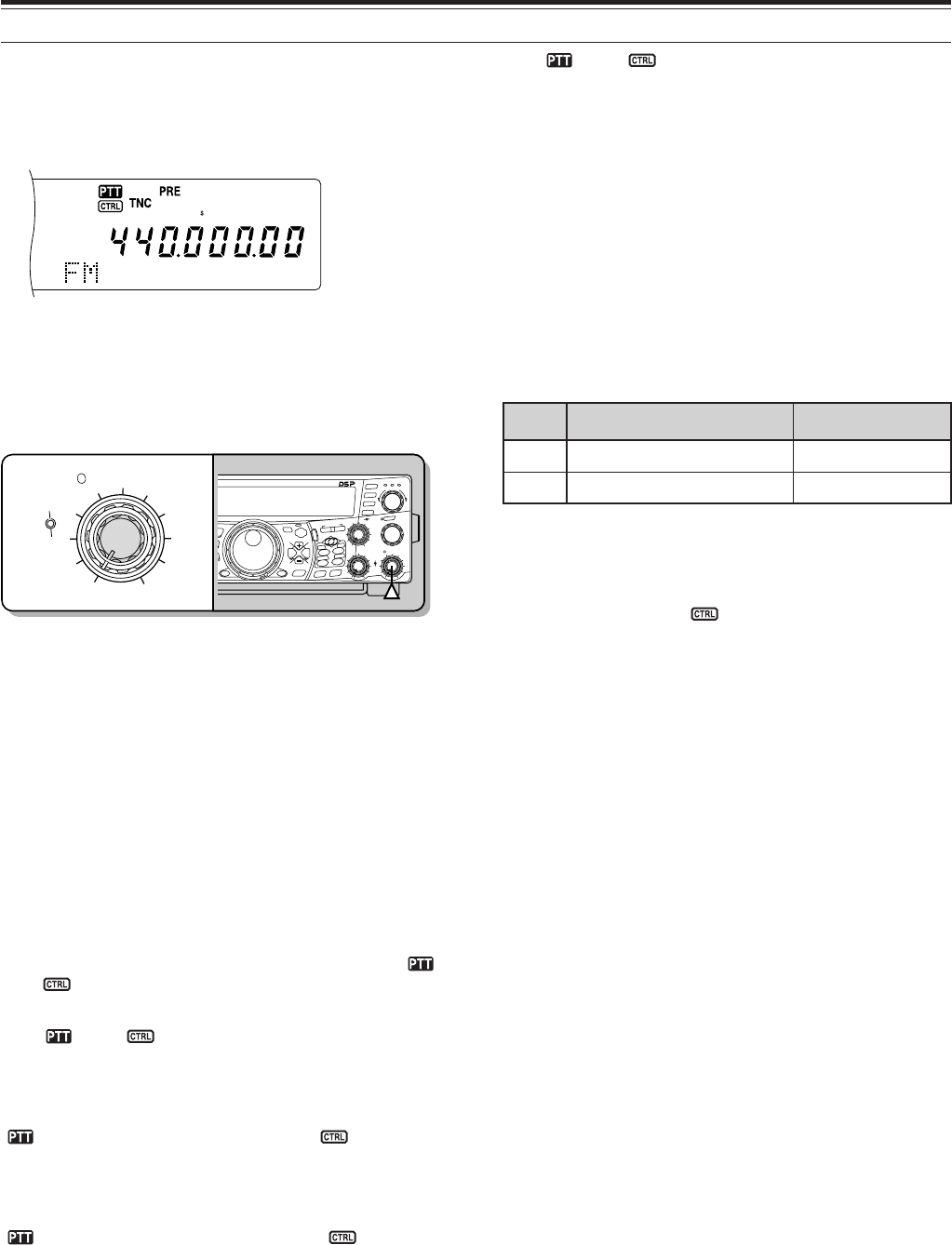
46
10 SUB-RECEIVER
The “ ” and “ ” icons are both on the sub-
receiver display:
• You can do all the above, plus transmit on the
SUB band frequency.
This transceiver provides many other methods for
selecting a frequency quickly. For further details, refer
to “SELECTING YOUR FREQUENCY” {page 37}.
SUB-RECEIVER PANEL METER
The multifunction meter measures the parameters
described in the table below. The S-meter appears
when in receive mode and the PWR meter appears
when in transmit mode. Peak readings for the
S- meter and PWR functions are held momentarily.
elacS yalpsiD etatSnoitcnuF
ShtgnertslangisdevieceRevieceR
RWPrewoptuptuotimsnarTtimsnarT
Note: Peak Hold readings cannot be deactivated.
SELECTING A MODE FOR THE SUB-RECEIVER
First, confirm that the “ ” icon is on the SUB band
display. If it is not, press [SUB] or [CTRL] to assign
the function controls to the SUB band.
The SUB band can only be used to transmit in FM
mode and receive in FM or AM mode. Press
[FM/ AM/ NAR] to toggle the operating mode for the
sub- receiver. The narrow bandwidth operation for
AM is not available for the SUB band frequency.
Refer to “NARROW BANDWIDTH FOR FM”
{page 29} for FM operation.
FM CTCSS OPERATION
You can assign an independent CTCSS tone to the
sub-receiver. Refer to “FM CTCSS OPERATION”
{page 35} for function and control details.
FM DCS OPERATION
You can assign an independent DCS code to the sub-
receiver. Refer to “FM DCS OPERATION” {page 36}
for function and control details.
TONE FREQ. ID SCAN
This function scans through all the tone frequencies
in order to identify the incoming tone frequency on
the receiving signal of the sub-receiver. Refer to
“TONE FREQ. ID SCAN” {page 34} for function and
control details.
DCS CODE ID SCAN
This function scans through all the DCS codes in
order to identify the incoming DCS code on the
receiving signal of sub-receiver. Refer to “DCS
CODE ID SCAN” {page 36} for function and control
details.
• Holding down the key changes the bands
continuously.
• If “MHz” is visible on the display, first press
[1MHz/ SEL] to exit from the 1 MHz Step Up/
Down mode.
ADJUSTING THE AUDIO FREQUENCY (AF) GAIN
Turn the SUB AF control clockwise to increase the
audio level and counterclockwise to decrease the
level.
SUB
CALL
C.IN
TO
B
B
SUB
EL
1MHz
CTRL
M
R
M
V
F
O
M
G
.
S
E
L
M
.
I
N
M
.
I
N
Q
U
IC
K
M
E
M
O
S
A
T
L
A
/
B
M
/S
R
E
V
T
R
A
C
E
M
A
IN
M
A
N
U
A
L
R
F
A
F
S
Q
L
S
U
B
C
H
M
U
L
T
I
B
C
M
A
IN
G
A
IN
V
F
O
/C
H
V
F
O
/M
A
=
B
S
P
L
IT
MENU
TF-
SET
MAIN SUB
SG.SEL
SCAN
RIT
CW TUNE
9.6k STA
RIT/SUB
CON
XIT
ALT
SET
CLEAR
P.C . T
_
+
HF/VHE/UHF ALL MODE MULTI BANDER TS-2000
AF
SQL
Note: The position of the SUB AF control does not affect the volume
of beeps caused by pressing buttons. The audio level for Packet
operation is also independent of the SUB AF control setting.
ADJUSTING THE SQUELCH
Turn the SUB SQL control clockwise when no signals
are present, to select the squelch level at which
background noise is just eliminated. The SUB band
LED turns off when the squelch is ON.
SELECTING A FREQUENCY
When you operate both the main transceiver and the
sub-receiver at the same time, you will be in one of
the following conditions. First, check where the “ ”
and “ ” icons are on the display, then follow the
instructions below.
The “ ” and “ ” icons are both on the MAIN band
display:
• Turn the RIT/ SUB control to adjust the sub-
receiver frequency.
“ ” is on the SUB band display and “ ” is on the
MAIN band display:
• Turn the RIT/ SUB control to adjust the sub-
receiver frequency.
“ ” is on the MAIN band display and “ ” is on the
SUB band display:
• Turn the RIT/ SUB control, the MULTI/ CH control,
or the Tuning control to adjust the frequency. Or,
directly enter the frequency using the numeric
keypad {page 37}. However, the input frequency
must be within the sub-receiver frequency range.
The frequency you selected may round up to the
nearest workable frequency step size {page 37}.
You cannot transmit on the sub-band frequency.
